A Portable Agriculture Environmental Sensor with a Photovoltaic Power Supply and Dynamic Active Sleep Scheme
Abstract
:1. Introduction
- (1)
- An innovative power management strategy: introducing photovoltaic power and using a PID-based dynamic active–sleep scheme to adjust the sleep time intervals according to assessments of the battery State of Charge (SoC), which significantly reduces the power consumption and maintains battery levels around 80% under fluctuating solar conditions, demonstrating that it is a sustainable method for energy management in smart agricultural devices.
- (2)
- Portable, robust, and reliable design: following the principles of compactness, waterproofing, and dustproofing with stable connectivity and a self-sustaining power supply, the prototype measures 90 mm × 90 mm × 150 mm and weighs 844 g. In addition, the sensor is capable of autonomous remote sensing.
- (3)
- Reliable remote monitoring of four environmental parameters: integration of high-precision digital sensors to accurately measure vital environmental data such as temperature, humidity, light intensity, and CO2 levels, with performance consistently comparable to even the CR800 data logger.
2. Materials and Methods
2.1. Overall Framework of the Sensor
- (1)
- Photovoltaic Power Supply: This subsystem harvests solar energy and converts it into electrical power to operate the sensor. It primarily consists of six solar panels (5 V, 0.3 W each), a Maximum Power Point Tracking (MPPT) [24,25] circuit module, a 12,000 mAh lithium iron phosphate (LFP) battery, and a DC-DC power module with 5 V and 3.3 V output.
- (2)
- Data Acquisition: The STM32F103 microcontroller unit (MCU) is responsible for data acquisition, collecting environmental data from three digital sensors (Sensirion SHT30 [26], ROHM BH1750 [27], and SenseAir S8 [28]) connected via I2C and UART interfaces. These sensors measure parameters such as temperature, humidity, light intensity, and CO2 levels.
- (3)
- Data Transmission: The MCU transmits the data to a cloud server using the BC35-G NB-IoT communication module, which operates at 850 MHz, in a format that combines timestamp and data values after data acquisition. Simultaneously, the data are stored locally on an SD card for redundancy.
- (4)
- Data Application: Users can access the cloud host server via computer or mobile devices. The data can be retrieved through APIs for various applications, including real-time environmental monitoring, intelligent crop management, and environmental optimization.
2.2. MPPT Based Photovoltaic Power Supply
2.3. Dynamic Active Sleep Scheme for Optimal Energy Management
3. Results
3.1. The Prototype Sensor Node
3.2. Power Consumption and Energy Optimization Results
3.3. Remote Monitoring of Four Environmental Parameters
4. Discussion
5. Conclusions
Author Contributions
Funding
Data Availability Statement
Conflicts of Interest
References
- Syrový, T.; Vik, R.; Pretl, S.; Syrová, L.; Čengery, J.; Hamáček, A.; Kubáč, L.; Menšík, L. Fully Printed Disposable IoT Soil Moisture Sensors for Precision Agriculture. Chemosensors 2020, 8, 125. [Google Scholar] [CrossRef]
- Ullo, L.; Silvia; Sinha, P.G. Advances in IoT and Smart Sensors for Remote Sensing and Agriculture Applications. Remote Sens. 2021, 13, 2585. [Google Scholar] [CrossRef]
- Brewster, C.; Roussaki, I.; Kalatzis, N.; Doolin, K.; Ellis, K. IoT in Agriculture: Designing a Europe-Wide Large-Scale Pilot. IEEE Commun. Mag. 2017, 55, 26–33. [Google Scholar] [CrossRef]
- Karthikamani, R.; Rajaguru, H. IoT based Smart Irrigation System using Raspberry Pi. In Proceedings of the 2021 Smart Technologies, Communication and Robotics (STCR), Sathyamangalam, India, 9–10 October 2021; pp. 1–3. [Google Scholar]
- Doshi, J.; Patel, T.; Bharti, S.k. Smart Farming using IoT, a solution for optimally monitoring farming conditions. Procedia Comput. Sci. 2019, 160, 746–751. [Google Scholar] [CrossRef]
- Sinha, B.; Dhanalakshmi, R. Recent advancements and challenges of Internet of Things in smart agriculture: A survey. Future Gener. Comput. Syst. 2021, 126, 169–184. [Google Scholar] [CrossRef]
- Deng, Y.; Zhu, C. Design of ZigBee IoT System in Smart Agricultural Greenhouses. Adv. Comput. Signals Syst. 2024, 8, 136–141. [Google Scholar] [CrossRef]
- Liu, L.; Jiang, W. Design of vegetable greenhouse monitoring system based on ZigBee and GPRS. In Proceedings of the 2018 4th International Conference on Control, Automation and Robotics (ICCAR), Auckland, New Zealand, 20–23 April 2018; pp. 336–339. [Google Scholar]
- Trinh, D.C.; Truvant, T.C.; Bui, T.D. Design of automatic irrigation system for greenhouse based on LoRa technology. In Proceedings of the 2018 International Conference on Advanced Technologies for Communications (ATC), Ho Chi Minh City, Vietnam, 18–20 October; pp. 72–77.
- Hao, D.; Qi, L.; Tairab, A.M.; Ahmed, A.; Azam, A.; Luo, D.; Pan, Y.; Zhang, Z.; Yan, J. Solar energy harvesting technologies for PV self-powered applications: A comprehensive review. Renew. Energy 2022, 188, 678–697. [Google Scholar] [CrossRef]
- Bouzguenda, M.; Rajamohamed, S.; Shwehdi, M.; Aldalbahi, A. Solar powered smart irrigation system based on low cost wireless network: A senior design project experience. Int. J. Electr. Eng. Educ. 2019, 59, 002072091986041. [Google Scholar] [CrossRef]
- Zhu, Y.; Song, J.; Dong, F. Applications of wireless sensor network in the agriculture environment monitoring. Procedia Eng. 2011, 16, 608–614. [Google Scholar] [CrossRef]
- Thompson, A.I.; Schomberg, H.H.; Evett, S.R.; Fisher, D.K.; Mirsky, S.B.; Reberg-Horton, S.C. Gateway-node wireless data collection system for environmental sensing. Agrosystems Geosci. Environ. 2021, 4, e20219. [Google Scholar] [CrossRef]
- Wang, C.; Li, J.; Yang, Y.; Ye, F. Combining Solar Energy Harvesting with Wireless Charging for Hybrid Wireless Sensor Networks. IEEE Trans. Mob. Comput. 2018, 17, 560–576. [Google Scholar] [CrossRef]
- Galmés, S.; Escolar, S. Analytical Model for the Duty Cycle in Solar-Based EH-WSN for Environmental Monitoring. Sensors 2018, 18, 2499. [Google Scholar] [CrossRef] [PubMed]
- Fang, W.; Mukherjee, M.; Shu, L.; Zhou, Z.; Hancke, G. Energy utilization concerned sleep scheduling in Wireless Powered Communication Networks. In Proceedings of the 2017 IEEE International Conference on Communications Workshops (ICC Workshops), Paris, France, 21–25 May 2017; pp. 558–563. [Google Scholar]
- Chien, L.; Drieberg, M.; Sebastian, P.; Hai, l. A simple solar energy harvester for wireless sensor networks. In Proceedings of the 2016 6th International Conference on Intelligent and Advanced Systems (ICIAS), Kuala Lumpur, Malaysia, 15–17 August 2016; pp. 1–6. [Google Scholar]
- Davcev, D.; Mitreski, K.; Trajkovic, S.; Nikolovski, V.; Koteli, N. IoT agriculture system based on LoRaWAN. In Proceedings of the 2018 14th IEEE International Workshop on Factory Communication Systems (WFCS), Imperia, Italy, 13–15 June 2018; pp. 1–4. [Google Scholar]
- Gsangaya, K.R.; Hajjaj, S.S.H.; Sultan, M.T.H.; Hua, L.S. Portable, wireless, and effective internet of things-based sensors for precision agriculture. Int. J. Environ. Sci. Technol. 2020, 17, 3901–3916. [Google Scholar] [CrossRef]
- Bazinet, Q.; Tang, L.; Bede, J.A.-O. Impact of Future Elevated Carbon Dioxide on C(3) Plant Resistance to Biotic Stresses. Mol. Plant-Microbe Interact. 2022, 35, 527–539. [Google Scholar] [CrossRef]
- Anderson, R.; Bayer, P.E.; Edwards, D. Climate change and the need for agricultural adaptation. Curr. Opin. Plant Biol. 2020, 56, 197–202. [Google Scholar] [CrossRef]
- Raymundo, R.; Asseng, S.; Robertson, R.; Petsakos, A.; Hoogenboom, G.; Quiroz, R.; Hareau, G.; Wolf, J. Climate change impact on global potato production. Eur. J. Agron. 2018, 100, 87–98. [Google Scholar] [CrossRef]
- Lee, Y.-H.; Sang, W.-G.; Baek, J.-K.; Kim, J.-H.; Shin, P.; Seo, M.-C.; Cho, J.-I. The effect of concurrent elevation in CO2 and temperature on the growth, photosynthesis, and yield of potato crops. PLoS ONE 2020, 15, e0241081. [Google Scholar] [CrossRef] [PubMed]
- Motahhir, S.; El Hammoumi, A.; El Ghzizal, A. The most used MPPT algorithms: Review and the suitable low-cost embedded board for each algorithm. J. Clean. Prod. 2020, 246, 118983. [Google Scholar] [CrossRef]
- Siddique, M.A.B.; Zhao, D.; Rehman, A.U.; Ouahada, K.; Hamam, H. Author Correction: An adapted model predictive control MPPT for validation of optimum GMPP tracking under partial shading conditions. Sci. Rep. 2024, 14, 11107. [Google Scholar] [CrossRef] [PubMed]
- Sensirion SHT30. Available online: https://mm.digikey.com/Volume0/opasdata/d220001/medias/docus/1067/HT_DS_SHT3x_DIS.pdf (accessed on 12 August 2023).
- ROHM BH1750. Available online: https://mm.digikey.com/Volume0/opasdata/d220001/medias/docus/6165/bh1750fvi-e.pdf (accessed on 12 August 2023).
- SenseAir S8. Available online: https://senseair.com/product/s8 (accessed on 12 August 2023).
- Bhargav, A.; Basiri, M.M. Guarded Low Power Hardware Implementations. In Proceedings of the 2023 IEEE 7th Conference on Information and Communication Technology (CICT), Jabalpur, India, 15–17 December 2023; pp. 1–5. [Google Scholar]
- Yazicioglu, R.; Torfs, T.; Penders, J.; Romero, I.; Kim, H.; Merken, P.; Gyselinckx, B.; Yoo, H.J.; Van Hoof, C. Ultra-low-power wearable biopotential sensor nodes. In Proceedings of the 2009 Annual International Conference of the IEEE Engineering in Medicine and Biology Society, Minneapolis, MN, USA, 3–6 September 2009; pp. 3205–3208. [Google Scholar] [CrossRef]
- Guo, L.; Hu, C.; Li, G. The SOC estimation of battery based on the method of improved Ampere-hour and Kalman filter. In Proceedings of the 2015 IEEE 10th Conference on Industrial Electronics and Applications (ICIEA), Auckland, New Zealand, 15–17 June 2015; pp. 1458–1460. [Google Scholar]
- Xing, J.; Wu, P. State of Charge Estimation of Lithium-Ion Battery Based on Improved Adaptive Unscented Kalman Filter. Sustainability 2021, 13, 5046. [Google Scholar] [CrossRef]
- Maka, A.O.M.; O’Donovan, T.S. Effect of thermal load on performance parameters of solar concentrating photovoltaic: High-efficiency solar cells. Energy Built Environ. 2022, 3, 201–209. [Google Scholar] [CrossRef]
- Li, Y.; Guo, J.; Pedersen, K.; Gurevich, L.; Stroe, D.-I. Recent Health Diagnosis Methods for Lithium-Ion Batteries. Batteries 2022, 8, 72. [Google Scholar] [CrossRef]
- The Weather Channel. Available online: http://www.weather.com.cn/weather1d/101230112.shtml#search (accessed on 12 August 2023).
- Valente, A.; Silva, S.; Duarte, D.; Cabral Pinto, F.; Soares, S. Low-Cost LoRaWAN Node for Agro-Intelligence IoT. Electronics 2020, 9, 987. [Google Scholar] [CrossRef]
- Botero-Valencia, J.S.; Mejia-Herrera, M.; Pearce, J.M. Low cost climate station for smart agriculture applications with photovoltaic energy and wireless communication. HardwareX 2022, 11, e00296. [Google Scholar] [CrossRef] [PubMed]
- McCauley, D.M.; Nackley, L.L.; Kelley, J. Demonstration of a low-cost and open-source platform for on-farm monitoring and decision support. Comput. Electron. Agric. 2021, 187, 106284. [Google Scholar] [CrossRef]
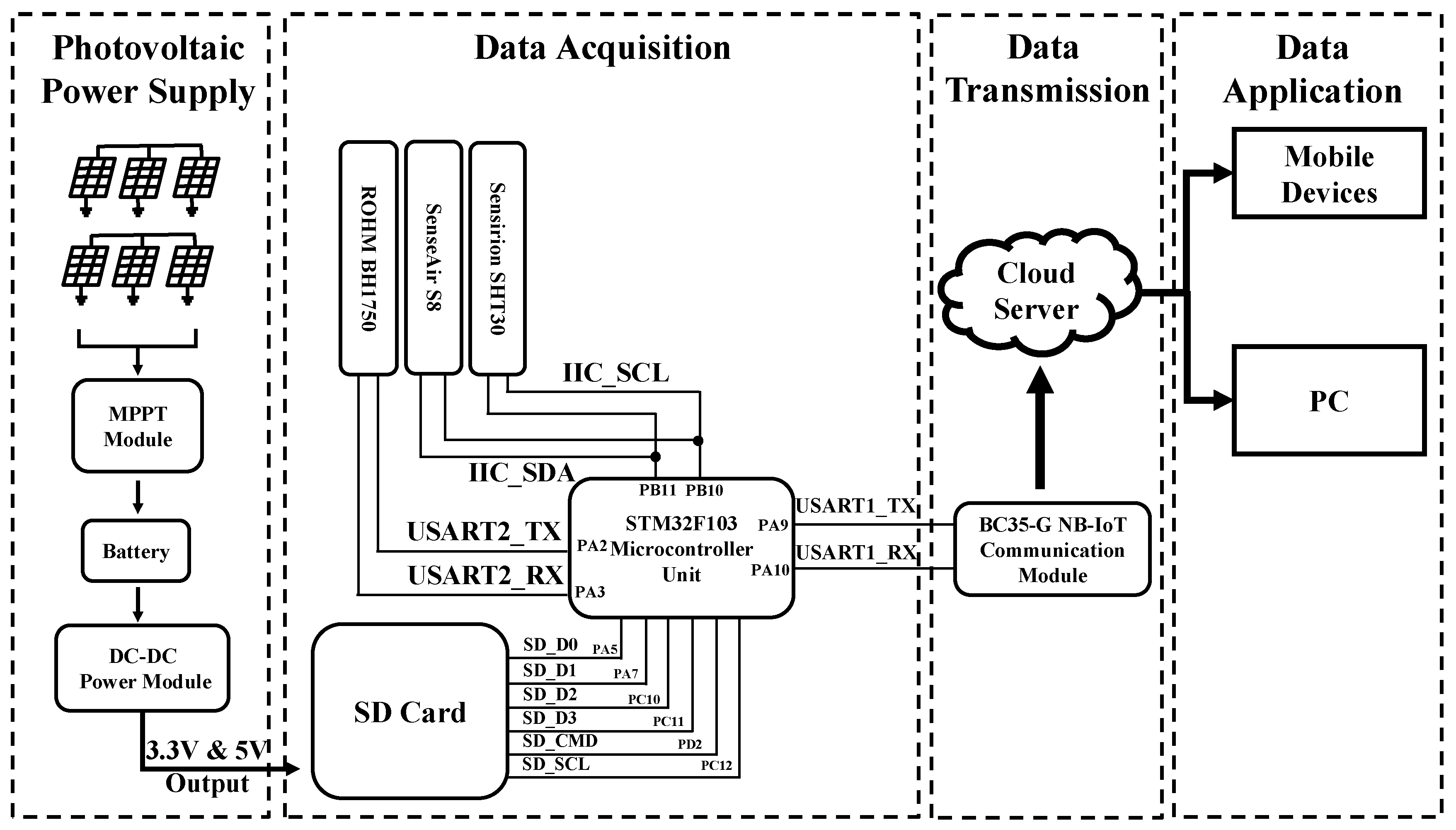
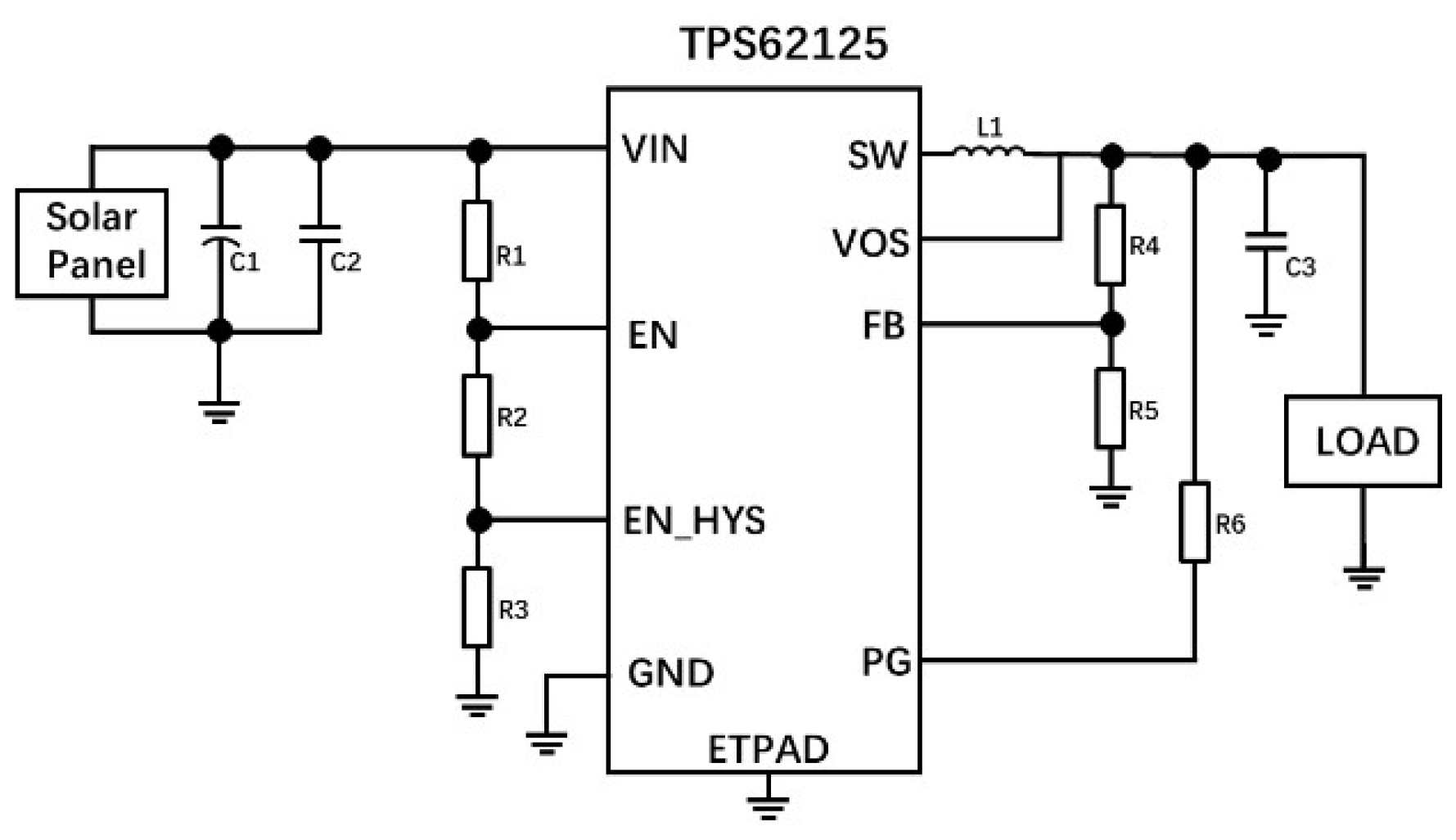
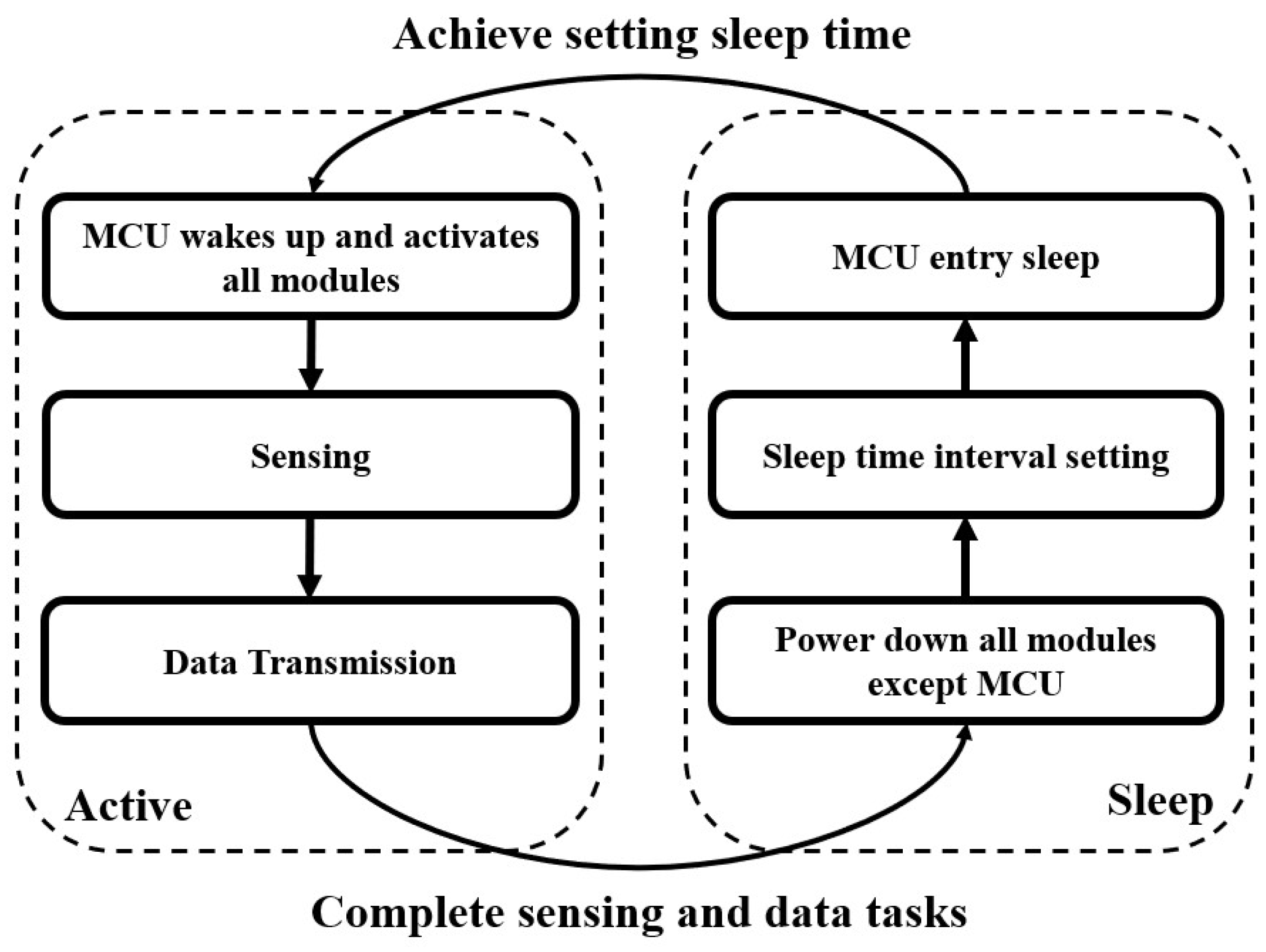
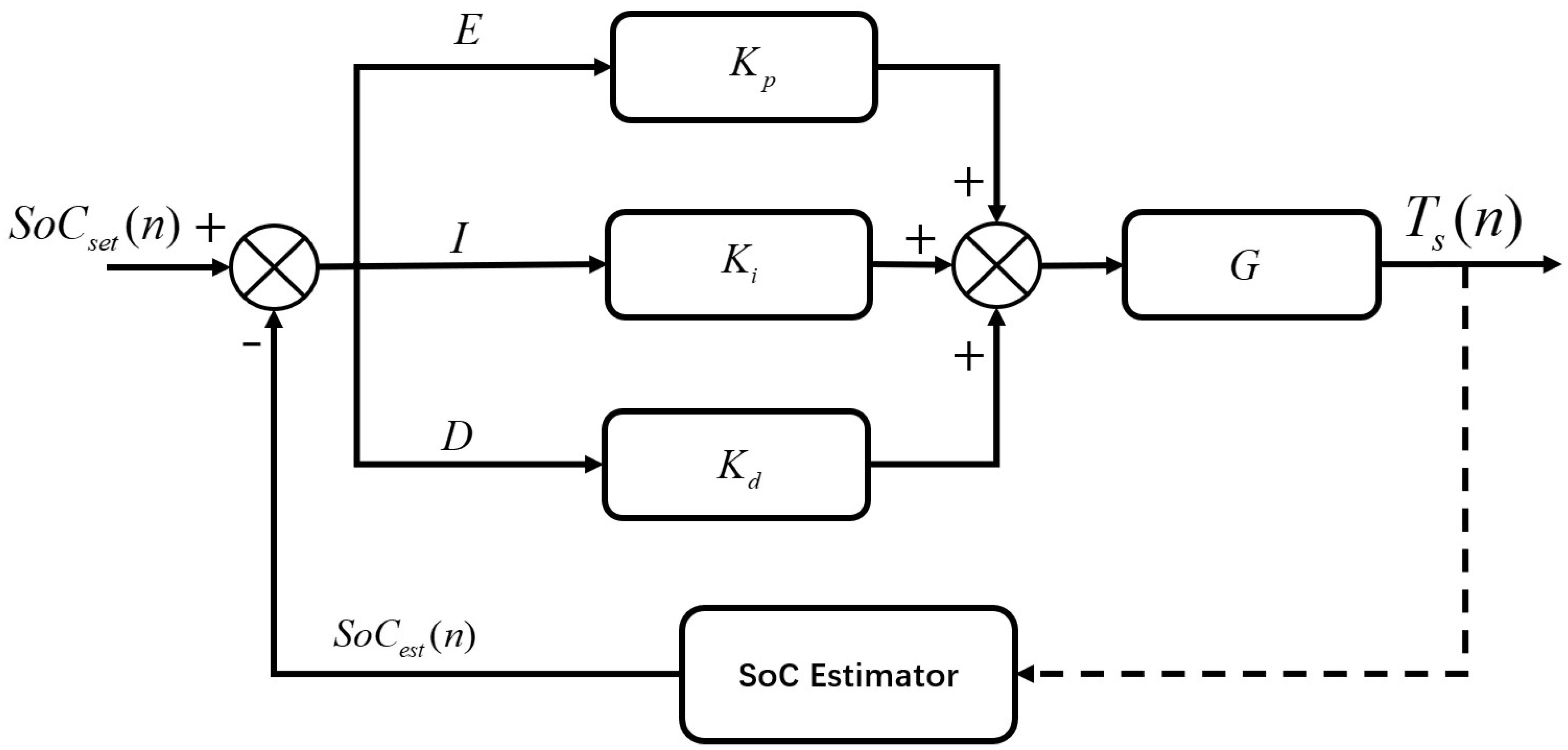
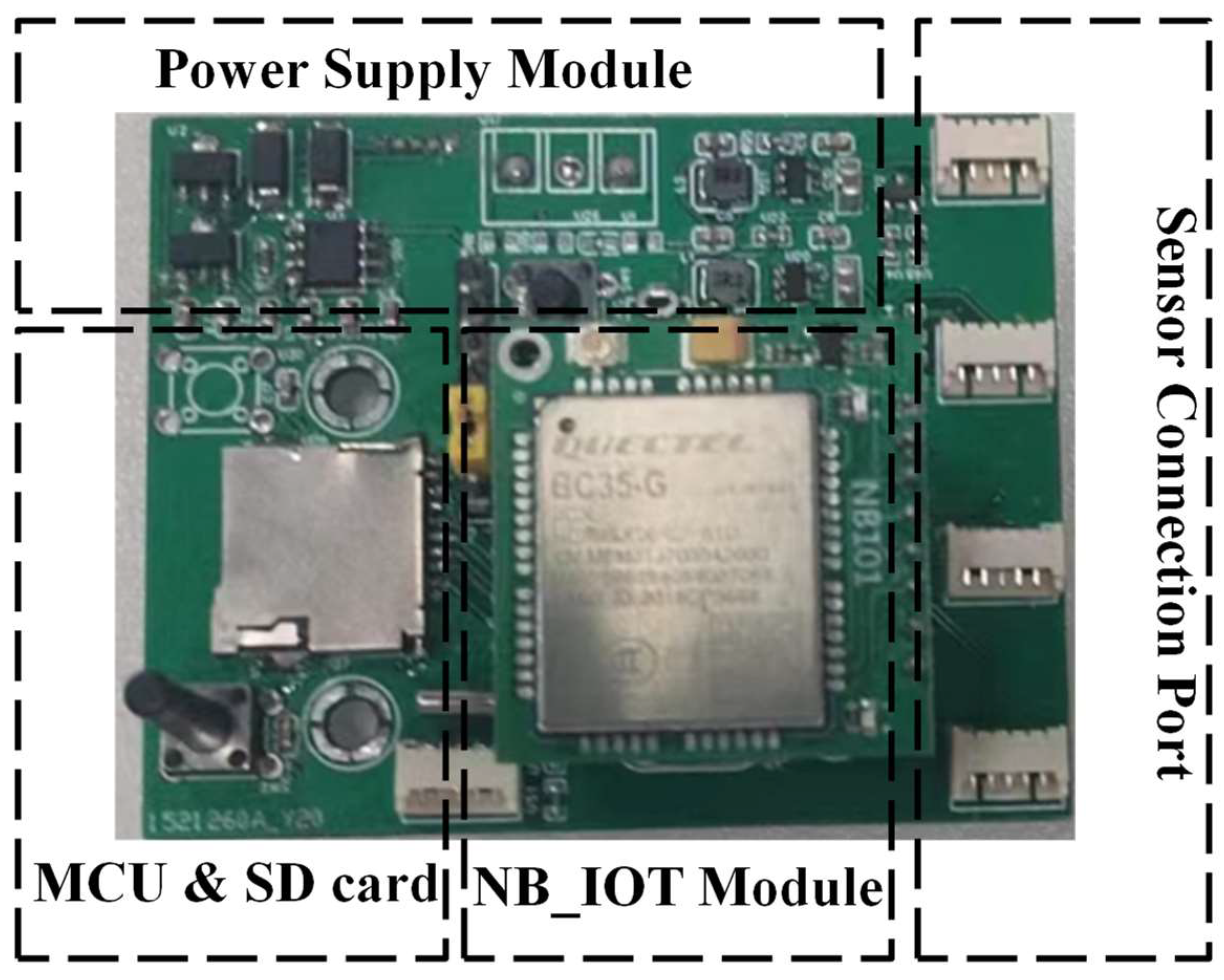
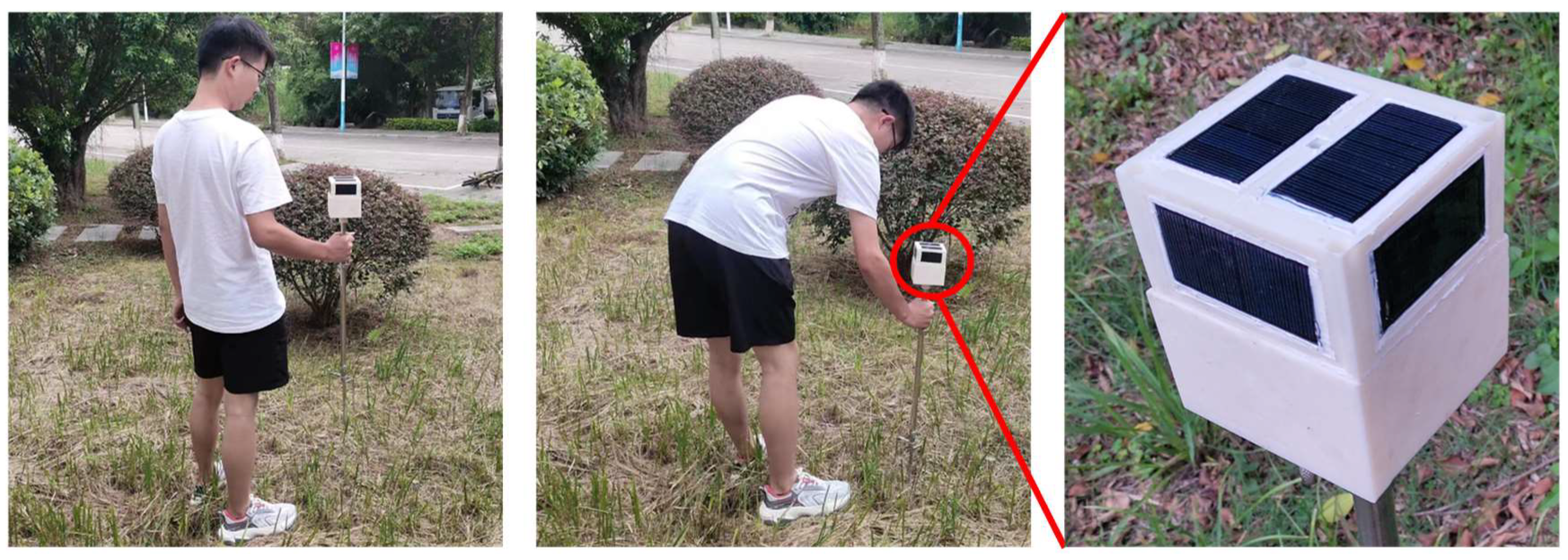

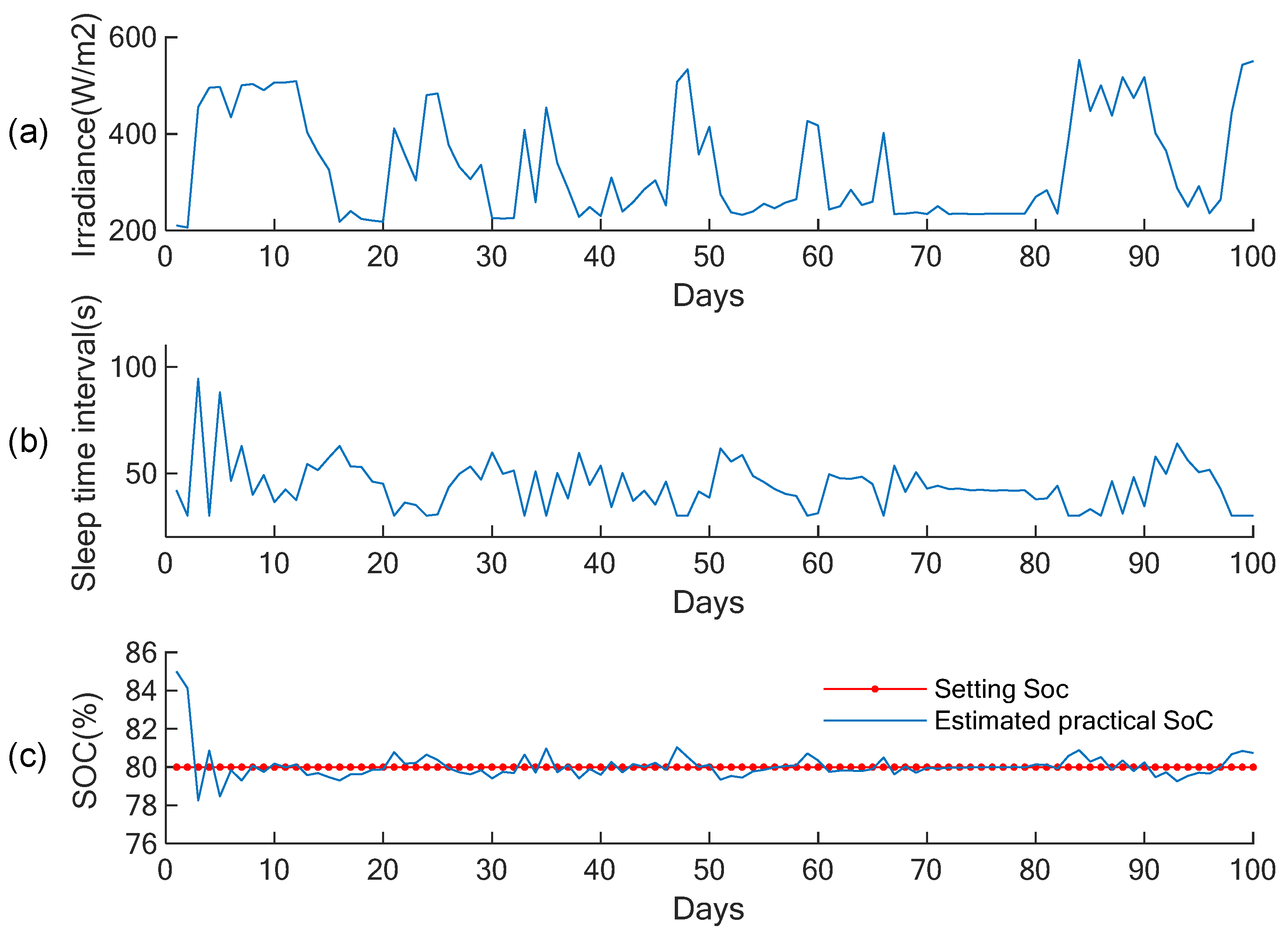


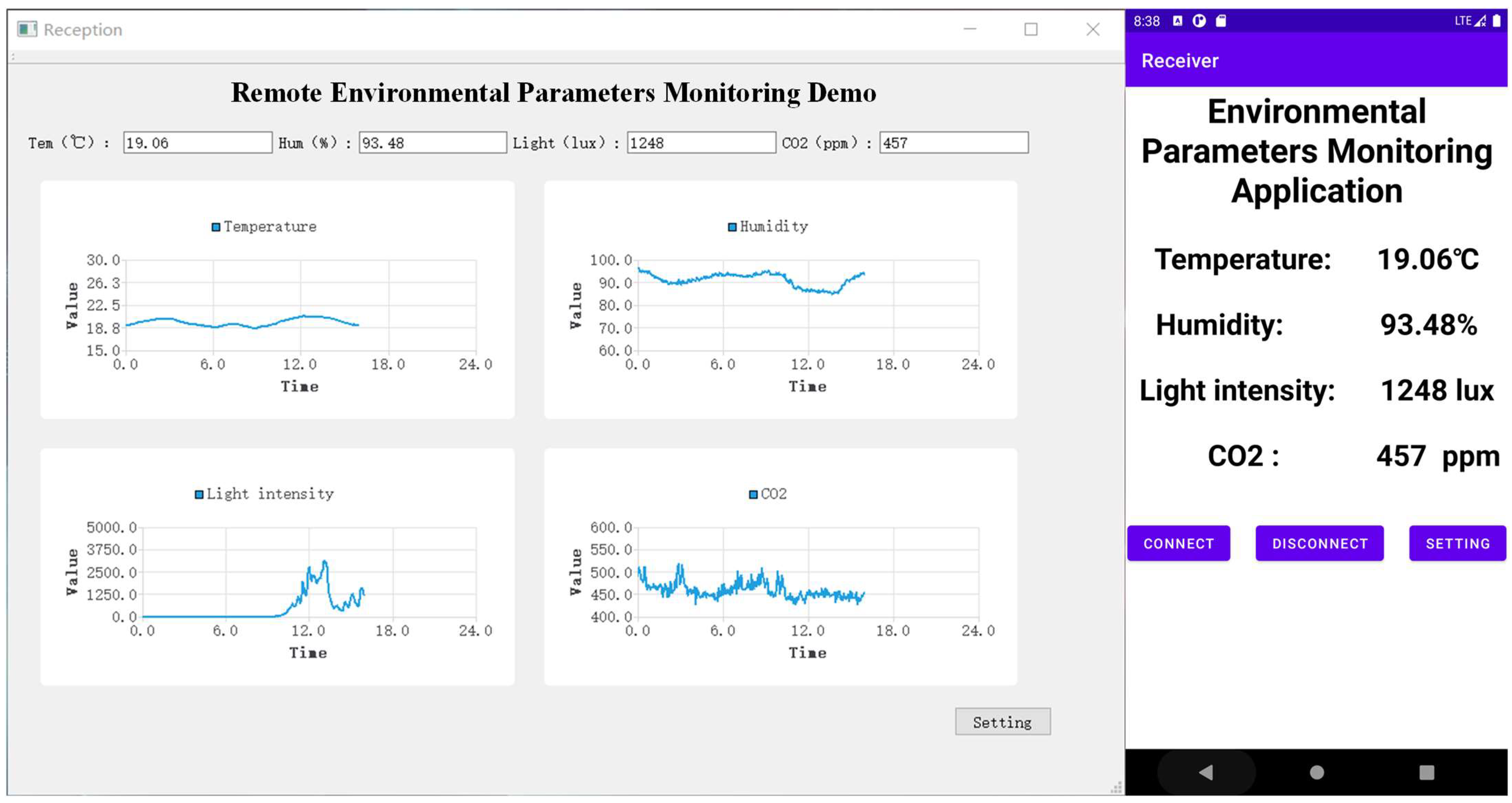
| Module | Function | Sleep | Active |
|---|---|---|---|
| MCU | Controlling | 2.5 | 101.3 |
| S8 | CO2 | 0 | 133.6 |
| SHT30 | Temperature and Humidity | 0 | 2.1 |
| BH1750 | Light intensity | 0 | 1.5 |
| SD Card and BC35-G | Storage and Communication | 0 | 226.5 |
| Total | 2.5 | 465 | |
| Time | Light Intensity (Lux) | Input | Output | Pout/Pin (mW) | Efficiency (%) | ||
|---|---|---|---|---|---|---|---|
| Vin (V) | Iin (mA) | Vout (V) | Iout (mA) | ||||
| 6:00 | 2695 | 5.9 | 0.0 | 0.0 | 0.0 | - | - |
| 7:00 | 6053 | 6.5 | 26.2 | 5.0 | 30.4 | 153.1/169.7 | 90.2 |
| 8:00 | 10,458 | 7.1 | 25.9 | 5.0 | 32.8 | 164.8/182.7 | 90.2 |
| 9:00 | 14,650 | 7.5 | 25.8 | 5.0 | 35.4 | 178.2/194.5 | 91.6 |
| 10:00 | 25,271 | 8.0 | 25.8 | 5.0 | 37.3 | 187.8/205.1 | 91.5 |
| 11:00 | 41,256 | 8.5 | 25.5 | 5.0 | 39.8 | 200.7/217.3 | 92.3 |
| 12:00 | 48,652 | 8.7 | 25.4 | 5.0 | 40.6 | 204.4/220.6 | 92.7 |
| 13:00 | 54,612 | 9.0 | 25.4 | 5.0 | 42.4 | 213.6/227.4 | 93.9 |
| 14:00 | 50,169 | 8.7 | 25.4 | 5.0 | 40.6 | 204.4/221.7 | 92.2 |
| 15:00 | 37,681 | 8.3 | 25.8 | 5.0 | 38.8 | 195.5/214.7 | 91.0 |
| 16:00 | 13,056 | 7.3 | 25.9 | 5.0 | 34.2 | 172.3/189.3 | 91.0 |
| 17:00 | 7265 | 6.7 | 26.3 | 5.0 | 31.5 | 158.3/175.6 | 90.2 |
| 18:00 | 2073 | 5.8 | 0.0 | 0.0 | 0.0 | - | - |
| Average * | - | 8.9 | 25.8 | 5.0 | 36.7 | 184.8/201.7 | 91.6 |
| Std * | - | 0.8 | 0.3 | 0.0 | 3.9 | 19.7/19.3 | 0.1 |
| Device | Sensor Types | Size (mm3) | Battery Life * | PV | Cost (USD) | Easy to Install |
|---|---|---|---|---|---|---|
| SoilH2O [13] | SW, ST, T, H | - | 20 days | No | ~100 | ☺ |
| Low-Cost LoRaWAN Node [36] | T, H, I, P, W | 85 × 65 ×35 | 6 months | Yes | ~50 | ☺☺ |
| Climatic Station [37] | T, H, I, P, W | - | 30 h | Yes | ~565 | ☺ |
| LOCOS [38] | T, H, W | - | 6 days | Yes | ~144 | ☺☺ |
| Proposed | T, H, I, CO2 | 90 × 90 × 150 | ~2 months | Yes | ~40 | ☺☺☺ |
Disclaimer/Publisher’s Note: The statements, opinions and data contained in all publications are solely those of the individual author(s) and contributor(s) and not of MDPI and/or the editor(s). MDPI and/or the editor(s) disclaim responsibility for any injury to people or property resulting from any ideas, methods, instructions or products referred to in the content. |
© 2024 by the authors. Licensee MDPI, Basel, Switzerland. This article is an open access article distributed under the terms and conditions of the Creative Commons Attribution (CC BY) license (https://creativecommons.org/licenses/by/4.0/).
Share and Cite
Luo, K.; Chen, Y.; Lin, R.; Liang, C.; Zhang, Q. A Portable Agriculture Environmental Sensor with a Photovoltaic Power Supply and Dynamic Active Sleep Scheme. Electronics 2024, 13, 2606. https://doi.org/10.3390/electronics13132606
Luo K, Chen Y, Lin R, Liang C, Zhang Q. A Portable Agriculture Environmental Sensor with a Photovoltaic Power Supply and Dynamic Active Sleep Scheme. Electronics. 2024; 13(13):2606. https://doi.org/10.3390/electronics13132606
Chicago/Turabian StyleLuo, Kan, Yu Chen, Renling Lin, Chaobing Liang, and Qirong Zhang. 2024. "A Portable Agriculture Environmental Sensor with a Photovoltaic Power Supply and Dynamic Active Sleep Scheme" Electronics 13, no. 13: 2606. https://doi.org/10.3390/electronics13132606
APA StyleLuo, K., Chen, Y., Lin, R., Liang, C., & Zhang, Q. (2024). A Portable Agriculture Environmental Sensor with a Photovoltaic Power Supply and Dynamic Active Sleep Scheme. Electronics, 13(13), 2606. https://doi.org/10.3390/electronics13132606






